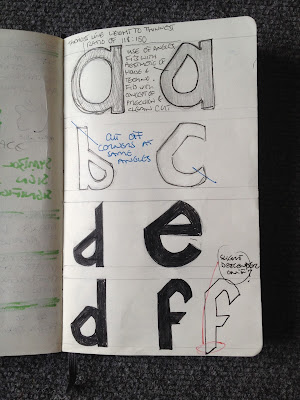We wrote out an email as a group asking for the input of some 3rd year students. We sent this email to the course administrator and asked him to forward it to all of the third year students. We got 5 responses which was perfect as this was the amount we were hoping to put into the poster. Each student provided images like we had asked and also a piece of advice. The advice they provided was more than we wanted ideally so we picked out a few key lines.
After picking out the quotes we wanted to use and collecting all of the images together that the students sent out we had to make the framework for the design of the image. We already had a plan for the way we wanted to lay the work out. The paper would fold into 24 rectangles to fit into the business card sized envelope. Each rectangle would have either a section of type or an image on.
I then set about producing the inDesign document. To start off with i set up the basic framework, adding columns, a baseline grid and changing the sizes of both the side and top margins.
This part was the easy bit. We then had to put all of the content into the framework. We spent time deciding upon typefaces, eventually settling on Futura for the titles and subheadings and Georgia for the body text. We aligned the images of the students earlier work in one column and then the students later work in another column with their quotes in the column between these. This grid system will make the hand out self explanatory and easy to understand whilst still having a nice balance to it. Shown below is an image of the print out prototype piece.
During crits we displayed the poster. We were pleased with the poster and the envelope we designed to put the poster inside. The feedback we got was really good, people seemed to like the design and the idea of it. We were given some feedback which I feel was useful and in the end helped to make the piece much stronger. Shown below is a photograph of notes from crits.
We started experimenting with the design of the envelope. We tried different typefaces and designs but we wanted to keep it really simple and to the point.
We made a net on illustrator, some of the variations we looked at are shown above. Also shown above are the first envelopes, the net as it is and also one after it had been assembled.
We started working on the improvements for the peice. Spending more time researching work that we could use as Inspiration. I got lots of inspiration from a designer named Sidney Lim Yi Xiang whose work I have displayed on my Design context blog.
We looked at some more typefaces as we were told that the one we were using looked too formal. After some deliberation we settled on Gotham as we felt this was simple enough so that it didn't distract from the image however it didn't make the piece look overly formal.
Drawing on another point that was made during the crit we simplified the text explaining what our piece was about. We reduced it to 6 short sentences that not only ready well but also looked nice once laid out. The final piece is shown below.
If we had more time I feel that this project could have been expanded upon. I think the idea of showing the improvement in designers work is really interesting. We could use this idea to make a book, possibly using work of designers who are now in Industry. Overall our group were pleased with the outcome of this project as it was visually interesting, easy to understand and we feel it is something that would actually fulfil its purpose, reassuring 1st year Graphic Design students.






















































